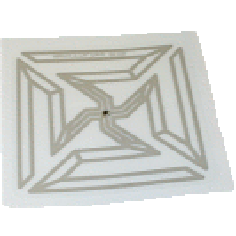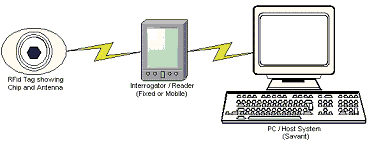
The use of RFID is growing steadily, and we can expect more implementations in the areas of tracking, maintenance, transport and logistics.
How does RFID work?
RFID is a means of identifying, tracking and detecting an object using radio frequency (RF) transmission.
Communication takes place between a reader (known as an INTERROGATOR) and a transponder (known as a CHIP connected to an antenna or more frequently as a TAG).

Tags are either active (powered by a battery) or passive (powered by the reader field) and are attached to an object. Every tag has a certain amount of internal memory in which it stores information about an object. When these tags pass through a field generated by an interrogator, they transmit information back to the interrogator, thereby allowing identification and communication.
Some types of RFID technology allow information to be written and stored on the tag. “Sensor tags” can record “real world” data from “on-tag” sensors and even more advanced active tags can communicate with other tags in close proximity using integrated “on-tag” transmitters.
What does TIG do?
TIG develops Mobile Computing and RFID solutions for all industries.
We provide consulting, tags, hardware, software solutions, and project implementation for RFID technology.
Research
TIG is continually researching different RFID technologies to educate our consultants and provide us with genuine practical information about the reality of RFID technology, focused on providing valuable business solutions.
Please contact us to discuss further.
Solutions
We have released RFID enabled solutions for:
- Asset Tracking
- Document Tracking
- Field Service
and are currently adding RFID support to our entire range.
Asset Tracking with RFID
Fixed Asset Tracking has traditionally been a labour intensive and paper based process while Radio Frequency Identification (RFID) has long been reserved for toll-ways billing and as an identification process for domestic pets.
When combined, these processes make for a powerful tracking and identification system.
Take a look at the article "Asset Tracking with RFID".
Where bar codes made significant in-roads into the cost of Fixed Asset Tracking by improving the accuracy of information and provided for electronic and real-time data flows, RFID based asset tracking shows even greater returns in the speed of tracking and the amount of information that can be processed.
Imagine being able to walk into a room and be able to confirm the presence of all assets and have this data recorded electronically by simply walking around!
